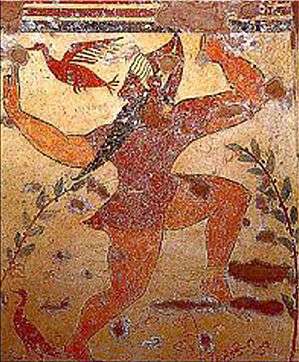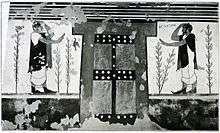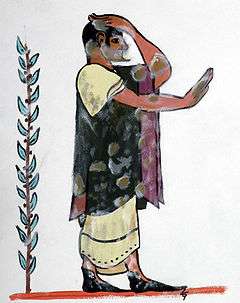Tomb of the Augurs
The Tomb of the Augurs (Italian Tomba degli Àuguri) is an Etruscan burial chamber so called for by a misinterpretation of one of the fresco figures on the right wall who was thought to be a Roman priest known as an augur. The tomb is located within the Necropolis of Monterozzi and dates to around 530-520 BC. This tomb is one of the first tombs in Tarquinia to have figural decoration on all four walls of its main or only chamber.[1]:xxxiv This tomb is also the first time a theme not of mythology, but instead depictions of Etruscan funerary rites and funerary games are seen.[2]:37

Description
The chamber is decorated with a figurative frieze on all four walls. The inclusion of plants and animals in all four frescos have led scholars to interpret that the events depicted in the tomb to take place outside.[1]:xxxiv Yet many of the figures depicted in the frieze, specifically those on the left and front wall, have been lost as the frescos have deteriorated over time and from exposure. The entrance wall has figures placed on it yet because of deterioration no one can say for sure who or what these figures are and the actions that they are depicting.
Rear Wall
On the center of the rear wall a painted door is placed. Scholars differ on interpretations of what the door denotes. Some interpret the door as a representational illustration of the door to the tomb. It is, however, more likely interpreted by scholars as a symbolic door or portal to the Underworld that acts as a barrier between the kingdom of the living and the kingdom of the dead.[1]:xxxiv Two figures on either side of the door each extend one arm towards the door and the other arm places the hand against their forehead in a gesture of salutation and mourning. The two men scholars either interpret as augurs or as mourners who are relatives of the deceased.[1]:xxxv The latter is thought to be the more accepted interpretation of the two figures since reading the name written on the wall next to the men, Apastanasar, contains the root of apa which means father. Above the door shows a lion and leopard killing a deer.

 |
The two augurs on either side of the door, rear wall of the tomb. |  |
Right Wall
The whole right wall depicts the funerary games in honor of the deceased. Funerary games were a tradition among many ancient societies, which is emphasized and illustrated to modern readers from Homer’s description in the Iliad of the contests staged at the funeral of Patroclus. Homer writes:
"Wrestling is the third event. Fairly typical, the prizes are a tripod [three 3-footed cauldrons given as gifts] worth 12 oxen for first prize, and a woman worth 4 oxen for the loser."[3]
This wrestling scene that Homer describes in the Iliad can be seen in the central motif of the right wall. It is also important to note the Etruscan funerary games, often bloody and deadly in nature, are seen as the original gladiatorial games as stated by the Romans. As a result, this part of Etruscan culture was inherited by the Romans into their own culture as a precursor to the spectacle of gladiatorial combat.[1]:xxxv
On the far end of the wall, closest to the rear wall, depicts a man wearing a purple tebenna, common Etruscan male robe, whose color eludes to the man being of elevated stature. The man is looking over his shoulder and gestures with a salutary pose to his two attendants, two figures of shorter stature. One attendant carries a folding stool, the official seat of the man’s high office, and the other attendant is huddled on the ground with a hood covering his head. Many scholars interpret this end of the motif of the crouched attendant as weeping/mourning for his master, which leads scholars to conclude that the man in the purple robes is most likely the deceased coming to watch his funeral games.[1]:xxxiv
In the center of the right wall shows the funerary game of wrestling in honor of the deceased. Depicted are two wrestlers – one younger and one older – who are wrestling in the Greek style [stark naked so no grabbing hold of any piece of clothing can take place]. The younger wrestler is identified as having no beard and having a slimmer torso while the older wrestler has a beard, an identifying marker for advanced age in a male, and a thicker upper body.[2]:38 Placed between the two wrestlers are three bowls of different colors, perhaps representing a silver, bronze and copper bowl, that are positioned one top of each other and are most likely the prize for the winner, as described in the Iliad.
To the left of the younger wrestler presides the agonothetes, the referee, who watches over the match. Written above the man is the word teverath leading scholars to question if this is the man’s name, occupation or title. Clad in a cloak with one arm outstretched and in the other he carries a lituus, an augur’s crook, he approaches the wrestling match. Two red birds are flying over the wrestling match, a detail that led to the initial misinterpretation of the scene depicting two augurs, are actually the deceased and referee watching the flying birds and the match. Hence the name, Tomb of the Augurs.[2]:38
On the closet section to the entrance of the right wall the is last motif, which some may consider quite gruesome. It is here the funerary game of bloodletting, a game performed to appease the soul of the deceased, is shown. A masked figure wearing a pointy hat, a long, black false beard, a black/blue jacket with white tassels, and a red loincloth is shown with the word phersu written above. The Etruscan word phersu, meaning "mask," "masked man," or even possibly "actor," since in Greek and Roman plays the actors always wore masks to show what sort of characters were being impersonated.[2]:40 Scholars debate that the phersu painted in this scene is an actor costumed to impersonate an executioner. It is said that when the Romans adopted the Etruscan custom of using slaves and criminals as gladiators, first in funeral games, and finally in exhibitions in vast arenas for the general public, once a gladiator fell mortally wounded and lay still in the arena, out came one masked and costumed man to deal him a "mercy blow" with a hammer to his forehead. But it wasn't a phersu that this fellow impersonated. It was Charun, the Etruscan demon who ferried the dead into Hades.[4] From this scholars even say that the masked man is in fact an actor impersonating Charun in the tomb of the Augurs and not a torturer or executioner.
The phersu is holding a rope that is attached to the collar of a black dog. When the phersu pulls on the rope, as depicted in the fresco, a nail on the dog's collar bites into its neck, enraging the animal and causing it to attack a tethered man. The tethered man has multiple bleeding bites on his legs, a sack tied over his head and a club in one hand to fend off the dog giving the bloodletting an exciting aspect for the Etruscan spectators to watch. Many scholars believe that this tethered man is a condemned criminal already sentenced to die that is being used for the funerary games.[4]
Left Wall
At the center of this wall two boxers can be seen fighting. To the right of the boxers another phersu can be seen. The action of the phersu is debated. Some interpret the phersu, who is wearing only a red tunic and no loincloth, as dancing solo surrounded by nature. Yet other scholars disagree with this interpretation. Instead other scholars take note of the remnants of two figures to the far left of the wall. One figure can be interpreted as an auleta, a musician playing the aulos.[5] The other, scholars note, only shows the figure’s legs. The lost figure’s legs are the same hue as the other athletes and are in the same position as the phersu’s at the other end of the wall. Scholars interpret this scene as the phersu being pursued by an opponent in some sort of funerary game.[2]:38
References
- 1 2 3 4 5 6 A History of Roman Art, Enhanced Edition, Wadsworth CENGAGE Learning, Boston, 2010
- 1 2 3 4 5 The Great Centuries of Painting: Etruscan Painting, Second Edition, The World Publishing Company, Cleveland, 1952
- ↑ Homer, "The Iliad", Harvard University Press, Cambridge, Book 23: The Funeral Games of Patroclus
- 1 2 Xanthippos, Funeral Games in the Tomb of the Augurs, 2011
- ↑ "Tomb of the Augurs - 3D model". Europeana. Retrieved 2015-11-06.
Coordinates: 42°14′18″N 11°47′41″E / 42.2382°N 11.7947°E